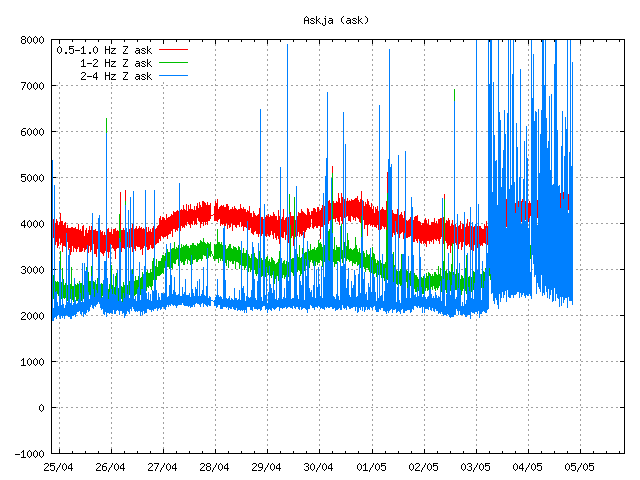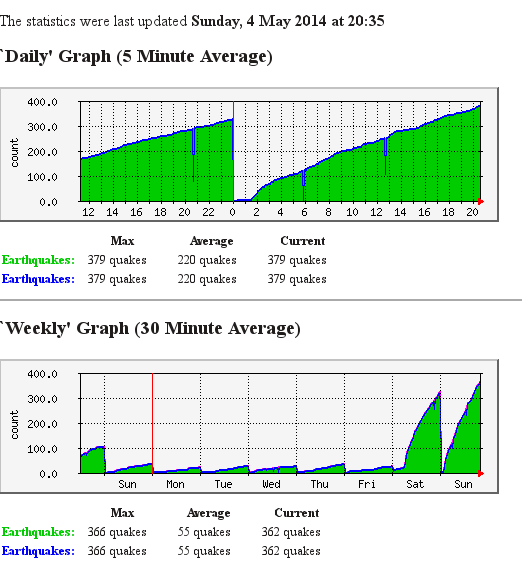The earthquake swarm that started yesterday (03-May-2014) in Herðubreiðartöl continues. Information about this earthquake swarm changes quickly so this article about it is going to get obsoleted quickly. The largest earthquake in past 24 hours had the magnitude 3,9. Since around midnight over 370 earthquakes have been recorded. This means the earthquake swarm is more powerful in terms of earthquakes today than it was at the same time yesterday.

The earthquake swarm in Herðubreiðdartögl today. Copyright of this image belongs to Icelandic Meteorological Office.

The evolution of the earthquake swarm in Herðubreiðartögl today. As be seen here this earthquake swarm is heavy in number of earthquakes being detected. Copyright of this image belongs to Icelandic Meteorological Office.

The earthquake swarm in Herðubreiðartöl at Askja SIL station. As can be seen here this earthquake swarm is close to continuous. There is some minor drop in activity few hours ago before the earthquake activity picks up again. Copyright of this image belongs to Icelandic Meteorological Office.

The earthquake swarm seen on the SIL station at Mókollar. It is close to what is seen on Askja SIL stations and other SIL stations around this area. Copyright of this image belongs to Icelandic Meteorological Office.

My earthquake counter today showing all the activity. This gives me good comparison to how many earthquakes where recorded yesterday. This image is released under Creative Commons Licence. See CC Licence page for more details.
I am expecting more earthquake activity in Herðubreiðartögl next hours and even days. Since currently there are no signs of this earthquake swarm slowing down. The largest earthquakes (above magnitude 3,0) appear clearly on my geophone network website.

New volcano coming?
It is difficult to know at this point. So far no nothing suggest that is going to happen in the short term.
Hi, Jon I’ve not posted in a long time but keep looking at envedur and your good self for updates. With its proximity to askja, has there been any more evidence of activity such as heating of the lake as was noticed last year. I know it’s a long way from sensors but IMO were paying quite a bit of attention to it and it is a caldera bordering this current activity is it not? It has been some considerable time now without an eruption, but plenty of indications of magma movement in general, the pressure valve has to open somewhere soon?
This area, that is having the earthquake swarm at the moment is not part of Askja volcano fissure swarm or Kverkfjöll volcano fissure swarm. Its between them.
As for Askja volcano, it remains quiet and there are no clear signs currently that something is about to happen in Askja volcano.
Where can i get this earthquake counter?
I use mrtg software for this and a shell script running with a cron job on my FreeBSD computer. This also works with Linux systems.
I can send you the shell script if you drop me an email.
Is the center of the cluster moving closer to Herðubreiðartögl? Seems like it is as of today. Compare the map here with the current map.
That might well be the case. Earthquake swarms often migrate over an fault area, reach the end and start again on the other end. I don’t even understand the physics of that.
The idea that a fault come unzipped, is that the item that you’re thinking of Jon? I was wondering if the magma, if that’s what it is, is migrating toward the old mount.
No, that works in a different way. An earthquake swarm can start in the middle of a fault, run to its end stop and then start at the other end some time later.
This is not clearly understood by science why this is. There are many ideas, but no hard evidence why this is the case.
Sometimes a new earthquake swarm starts on the other end of fault after the first one ends. Sometimes that is not the case and that is not understood.
When magma opens up a fault, it starts at one end with a flow of lava and the magma creates the new rift as it pushes forward creating new fissure that is erupting. Its a different process and slightly better understood than earthquake activity moving a long fault lines.